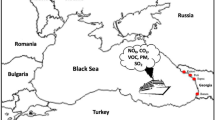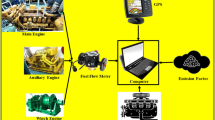Abstract
Rapid economic growth has escalated India’s share in international trade. The pressure on these ports, which handle a substantial portion of the trade, has increased to perform with optimal efficiency, and decrease turnaround time so as to increase the number of ships visiting the port area. The caveat is that increased shipping activity is accompanied by enhanced emissions of harmful pollutants and green house gases. This study has revealed increased turnaround time for ships resulting in substantial emissions from auxiliary engines. There should be an optimum balance between operational control and environmental control of pollutants. Kolkata is a megacity with active riverine ports that can generate high levels of air quality emissions, especially NOx, SOx and particulate matter. An exhaustive annual emissions inventory based on ocean going vessels activity has been developed for 2013–2014 for Kolkata port, using recent EPA approved methodology. This includes greenhouse gas emissions from marine engines as well. The study indicates that amongst the different categories of ocean going ships, containers contribute the most (49%) of air and greenhouse gas emissions in 75th percentile class and above followed by general cargo (14%) and oil tankers (13%). The study depicts existing status of marine emissions in Kolkata port from ocean going vessels, which would serve in development of integrated air quality and climate change management plans and serve as a prototype for other major ports of India.




Similar content being viewed by others
References
C.Y. Jaja, Freight traffic at Nigerian seaports: problems and prospects. Soc. Sci. 6(4), 250–258 (2011)
A. Mandal, S. Roychowdhury, J. Biswas, Performance analysis of major ports in India: a quantitative approach. Int. J. Bus. Perform. Manag. 17(3), 345–364 (2016)
R. Pokhrel, H. Lee, Estimation of air pollution from the OGVs and its dispersion in a coastal area. Ocean Eng. 101(1), 275–284 (2015)
Z.M. Farooqui, K. John, N. Sule, Evaluation of anthropogenic air emissions from marine engines in a coastal urban airshed of texas. J. Environ. Prot. 4, 722–731 (2013)
J.J. Corbett, J.J. Winebrake, E.H. Green, P. Kasibhatla, V. Eyring, A. Lauer, Mortality from ship emissions: a global assessment. Environ. Sci. Technol. 41, 8512–8518 (2007)
Ø. Andersen, E. Sørgard, J.K. Sundet, S.B. Dalsøren, S.A. Iskasen, T.F. Berglen, G. Gravir, Emission from international sea transportation and environmental impact. J. Geophys. Res. Atmos.(1984–2012) 108, 4560 (2003). doi:10.1029/2002JD002898
M. Viana, P. Hammingh, A. Colette, X. Querol, B. Degraeuwe, I. de Vlieger, J. van Ardenne, Impact of maritime transport on costal air quality in Europe. Atmos. Environ. 90, 96–105 (2014)
M. Pandolfi, Y. Gonzalez-Castanedo, A. Alastuey, J.D. de la Rosa, E. Mantilla, A.S. de la Campa, X. Querol, J. Pey, F. Amato, T. Moreno, Source apportionment of PM(10) and PM(2.5) at multiple sites in the strait of Gibraltar by PMF: impact of shipping emissions. Environ. Sci. Pollut. Res. 18, 260–269 (2011)
Time for International Action on CO2 Emissions from Shipping, http://ec.europa.eu/clima/policies/transport/shipping/docs/marine_transport_en.pdf. Accessed 4 July 2015
H.K. Lai, H. Tsang, J. Chau, C.H. Lee, S.M. McGhee, A.J. Hedley, C.M. Won, Health impact assessment of marine emissions in pearl river delta region. Mar. Pollut. Bull. 66(1–2), 158–163 (2013)
IMO MARPOL Annex VI, 2013, MARPOL Annex VI and NTC 2008 with Guidelines for Implementation, 2013 edn. IMO. http://www.imo.org. Accessed 3 July 2015
I.H.S Fairplay, Register of Ships 2010–2011, Lombard House, Surrey
ICF International, Current Methodologies in Preparing Mobile Sources Port-related Emissions Inventories: Final Report, Prepared for US Environmental Protection Agency (USEPA), 116 (2009)
C.Trozzi, Update of Emission Estimate Methodology for Maritime Navigation, in Techne Consulting report ETC.EF.10.DD (2010)
Entec UK Limited, Quantification of Emissions from Ships Associated with Ship Movements between Ports in the European Community, prepared for the European Commission. Available online http://www.europa.eu.int/comm/environment/air/background.htm.(2002)
Lloyd’s Register Engineering Services, Marine exhaust emissions research programme, Phase II: transient emission trials. (London, 1993)
D.A. Cooper, T. Gustafsson, Methodology for calculating emissions from ships: two emission factors for 2004 reporting (Swedish Methodology for Environmental Data, Stockholm, 2004)
Acknowledgement
The authors are thankful to Kolkata Port Trust, India for providing required shipping activity data to support this study. The authors are also thankful to Ohio University, Athens, USA for contribution towards data analyses. The authors wish to acknowledge the anonymous reviewer whose comments helped to significantly improve quality of the paper.
Author information
Authors and Affiliations
Corresponding author
Rights and permissions
About this article
Cite this article
Mandal, A., Biswas, J., Roychowdhury, S. et al. Appraisal of Emissions from Ocean-going Vessels Coming to Kolkata Port, India. J. Inst. Eng. India Ser. A 98, 387–395 (2017). https://doi.org/10.1007/s40030-017-0238-7
Received:
Accepted:
Published:
Issue Date:
DOI: https://doi.org/10.1007/s40030-017-0238-7




